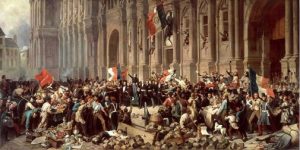L’Union Ouvrière (The Workers’ Union) (1843) by Flora Tristan
“Only when men and women work with their hands and are dignified by it, will this great, desirable productivity take place.” – Flora Tristan
L’Union Ouvrière (The Workers’ Union) was published in 1843 by the French utopian socialist, Flora Tristan (1803-1844). In this major text of the history of early socialist feminism she argues that the only way to liberate the working class is to liberate and integrate women into the socialist movement. To achieve these aims she proposes a “Universal Worker’s Union” in which all members of the proletariat would belong regardless of profession or sex.
The L’Union Ouvrière was Flora Tristan’s final work before her death caused by illness in 1844. In many ways this document, inspired by other early French socialist authors, including Henri Saint-Simonians (1760-1825) and Charles Fourier (1772-1937), was an amalgam of her personal and political experiences.
The first section of L’Union Ouvrière is an appeal to the proletariat to form a single, universal trade union organization. Tristan states that eligibility will be extended to anyone that “works with his or her hands.” From this group she excludes soldiers, sailors, and beggars, who were all dependent on others. She encourages the incorporation of women, stating that their involvement in the trade union is “of the utmost importance.” In the following section of the document Tristan appeals to the King of France, Louis Phillipe I. Tristan politely demands that the king, installed by the power of the people, acknowledge the people’s fundamental right to work. This was a significant demand during the conservative Orléanist rule. Tristan then turns to the clergymen of the Catholic and continues her appeal by stating that the goals of the Worker’s Union and the Catholic Church are one and the same. She argues that the clergy have the power to influence both the rich and the poor and should use this power to encourage their dioceses to support the Worker’s Union. In addition, she states “communion means universal brotherhood” and this is a primary tenet of both the Catholic Church and the Worker’s Union.
The final and longest appeal is to women—women of every class and nation. She acknowledges the power held by the bourgeoisie women to aid their proletariat sisters and she implores them to embrace their generosity and help finance the Worker’s Union. She encourages women of the proletariat to enlist their sons and daughters in the union and publically defend its formation.
L’Union Ouvrière appeals to major societal institutions to support the building of a union “Palaces” that would house members of the Worker’s Union and their families and provide education and services to them. Emphasis is placed on children’s education and Tristan makes provisions for a “moral,” but “analytical education” that would promote “the simultaneous development of the loving and intellectual faculties of every child.”
While Tristan’s L’Union Ouvrière is revolutionary in some aspects, it has also been criticized by some modern feminist historians for emphasizing the traditional gendered roles of women. Tristan encourages the incorporation of women into the Worker’s Union, but primarily as the wives and mother’s of workers rather than workers in their own right. The L’Union Ouvrière is nevertheless still an important text today, because it is one of the first document that combined the struggle of the working class with the plight of women. This idea became integral to later socialist theory and influenced the writings of Marx and Engels. Tristan’s work is essential in understanding how the situation of the working class and women were inextricably tied together. Her vision influenced the French working class long-lastingly beyond the Revolutions of 1848.
Lauren Overton, Chemistry and Neuroscience, Class of 2019
Sources
Literature and Websites
- Tristan, Flora, “L’Union Ouvrière,” in Lives and Voices, Sources in European Women’s History, edited by Lisa DiCaprio and Merry E. Weisner, 102. Boston: Houghton Mifflin Company, 1998.
- Leveratt, Mandy, “Reviewed Work: The Workers’ Union by Flora Tristan, Beverly Livingston,” Labour History, no. 48 (1985): 107-108.
Images



